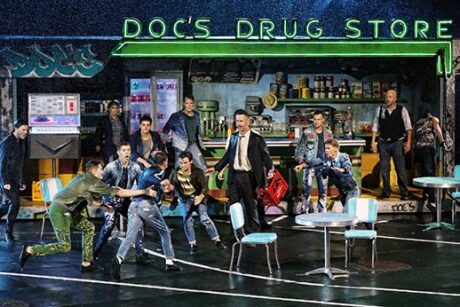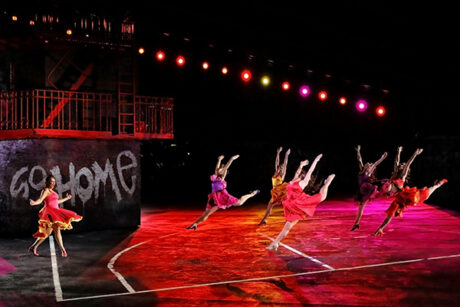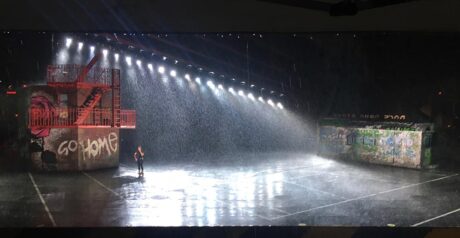
SYDNEY – After eight years of Handa Opera on Sydney Harbour (HOSH), Opera Australia presented West Side Story, the first musical to be performed on the iconic harbour-side stage.
Boasting a stage that is almost two and a half times larger than any indoor stage in Australia, the Handa Opera on Sydney Harbour series is one of the biggest outdoor theatrical events in the country, and a highlight of the Australian cultural calendar.
More details from Chameleon (http://www.chameleon-touring.com.au/):

The stage and venue are constructed from the ground up in just 25 days by a crew of approximately 150 people for an exclusive four week performance season. The West Side Story set, designed by award-winning designer Brian Thomson, is an urban New York City-inspired stage design that features a highway overpass that weighs approximately ten tonnes and soars 15 metres above the stage, three custom-built subway cars and the West Side Story letters spelled across the back of the stage.

Cranes positioned the 80 tonne foundation of the stage onto nine pylons in the water to create a seemingly floating stage which can support up to 150 tonne in weight. Throughout the performance, the stage is accessed via a floating walkway that connects land and sea. The custom-built venue includes the expansive stage which sits above the Harbour, an orchestra pit, which is hidden in the ‘underworld’ directly beneath the stage, plus on land there’s site and crew offices, dressing rooms, and grandstand seating for approximately 3,000 people. Along with the grandstand, there are multiple bars, food outlets, a restaurant and very respectable toilets!
For every one of the nine productions over the years, Chameleon Touring Systems has been an integral part of the design process, supplying lighting and crew for what can be a difficult set up.

For West Side Story John Rayment was appointed lighting designer and he wanted to find a style that allowed him to move from a seemingly ‘straight’ lighting plot into a more theatrical expression when it came to some of the musical numbers without jarring. After all, it’s a musical set in a naturalistic world, not a fantasy land.
“Not all the musical numbers call for an ‘it’s showtime!’ approach,” he explained. “By simply adding the floor cross-light to a monochrome street scene was enough of a lift for a couple of dance numbers. It all had to have an overall plausible sense of being “real”. That said, there are grand moments in there for going off to dreamland just a bit.”
This year, the action was pushed quite downstage and the large set elements restricted the full use of the standard north and south ‘goalpost’ lighting positions. The downstage five lanterns of each of the two truss runs on both goalposts did the bulk of the work from these positions (that is 10 per side) with the remainder of the lanterns doing more set dressing and space shaping duties. Each goalpost held 13 Martin MAC III Performance and 14 Philips Vari-Lite VL3500Q Spot.

The huge Freeway structure provided a great opportunity for rigging a big horizontal backlight position (which is always a challenge in this venue) and to make good shapes and visual interest. The clean downstage extremities of the stage meant that John could rig some very useful cross-lights to behave like ballet booms / shin busters – and they are used quite frequently.
Major challenges for John included making the ‘real world’ not look too theatrical but still hold their own. Or, if you like, finding the starting point for the crossover between styles. Also, the dialogue scenes had to stand up against the musical numbers and not feel too much of a let-down visually.
The 25 metre angled backlight run under the freeway structure presented particular issues: every group tilt preset of the 20 Martin MAC2000 Wash XB had to be individually composed since no two lanterns had the same angle of throw.

“There were weight restrictions on what I could outrig off the ends of the freeway structure as additional (and vertical) backlight runs,” added John. “That had a bearing on numbers. And the engineering realities of the structure meant that lanterns could not be rigged exactly where I would have preferred in relation to set.”
The centre FOH tower is always a compromise between the rigged movers on the outside and the followspots inside as the followspots have to make their shots between the two levels of lighting trusses, which means they rig differently than the other FOH towers. Each of the three FOH towers held a mixture of Claypaky Alpha 1500, VL3000 Spot and VL3500Q.
The side followspots on the goalposts are less powerful than the four FOH ones – 2.5K vs 4K. This has to do with physical conditions as you simply cannot swing a long instrument like a 4K around up there to make the range of pick-ups required, due to the position housing structure.
To be perfectly honest, Chameleon cannot send out most of their latest and best fixtures to a gig where they are hammered by a hostile environment. Wind, rain, salt, rain, possums ….. and lots more rain all take their toll. Fortunately this year, Chameleon had their new IP-rated PROLIGHT Panoramas which proved to be a bit of a star!

“I was very happy with them and they did a great job as the floor cross-lights,” said John. “The IP rating is a real bonus, and it’s always good to know that if everything else went belly-up, we could still plough on with the Panoramas! The performers took quite some time getting used to the bright output! Floor-based cross lights are always a challenge for dancers but putting them on a vast rake, with a lot of rain, made it all just that bit more confronting. And well done those performers – they came through magnificently. The Panoramas were robust and never let us down.”
Jason Fripp programmed the show as he and John go back quite a long way, over many shows, and they have a great understanding. They set up the pre-visualisation out at the Olympic Park rehearsal venue for a week.
“It was great to be able to watch the company run through a number and then take that freshly into the pre-vis work,” remarked John. “Rehearsal videos were also vital. We arrived at stage rehearsals with stuff for every scene in the console and the first pass of the cue synopsis in the stage manager’s prompt copy. That meant we never held anybody up. Jason and I worked every night after rehearsals – latest finish was around 3am from memory. Everything always looks better in the still of the wee hours! And we had a couple of possums to keep us company in the tent.”
The weather Gods have been particularly unkind this season with unbelievable rain almost the norm. The Chameleon crew have had to work hard to keep the gear working and the constant rain has made maintenance very difficult at times.
“Then there was the part of the road case that the console was sitting in, filling up with water via some strange trickle-from-somewhere effect but luckily we discovered it before it got to the fan vents … just!” added John. “The water also made any backlight very difficult to judge as the bounce off the wet raked stage surface was quite nasty.
“Apart from the fact that Chameleon won’t give me nice shiny new lanterns to trash in the weather, their service was great! Sam, Liam and Mikayla were all terrific and ran a good crew – great attitude and didn’t let a little bit of water get them down. Much. Well, to be fair, it was monsoonal at times!”
Photos: Opera Australia, Brian Thomson, John Rayment


